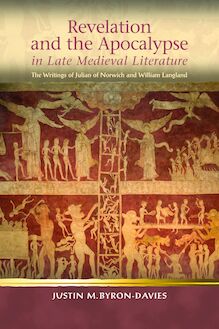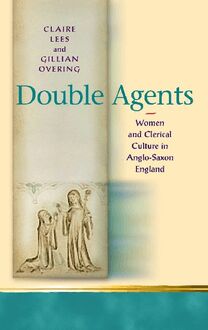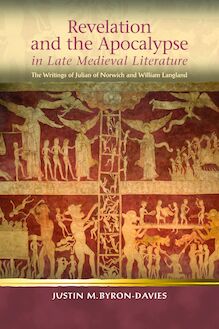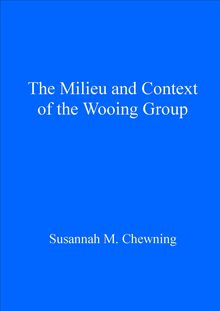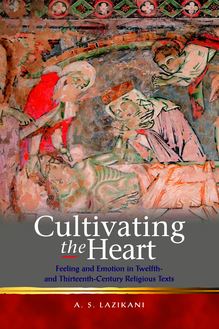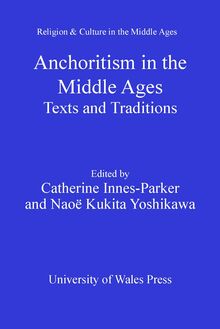Cognitive Sciences and Medieval Studies , livre ebook
269
pages
English
Ebooks
2020
Obtenez un accès à la bibliothèque pour le consulter en ligne En savoir plus
Découvre YouScribe en t'inscrivant gratuitement
Découvre YouScribe en t'inscrivant gratuitement
269
pages
English
Ebooks
2020
Obtenez un accès à la bibliothèque pour le consulter en ligne En savoir plus
Publié par
Date de parution
01 novembre 2020
Nombre de lectures
1
EAN13
9781786836755
Langue
English
Poids de l'ouvrage
9 Mo
With the rapid development of the cognitive sciences and their importance to how we contemplate questions about the mind and society, recent research in the humanities has been characterised by a ‘cognitive turn’. For their part, the humanities play an important role in forming popular ideas of the human mind and in analysing the way cognitive, psychological and emotional phenomena are experienced in time and space. This collection aims to inspire medievalists and other scholars within the humanities to engage with the tools and investigative methodologies deriving from cognitive sciences. Contributors explore topics including medieval and modern philosophy of mind, the psychology of religion, the history of psychological medicine and the re-emergence of the body in cognition. What is the value of mapping how neurons fire when engaging with literature and art? How can we understand psychological stress as a historically specific phenomenon? What can medieval mystics teach us about contemplation and cognition?
Introduction: Cognitive Science and Medieval Studies
Juliana Dresvina and Victoria Blud
I Questions of method
1. How Modular Are Medieval Cognitive Theories? - José Filipe Silva
2. An Unrealized Conversation: Medieval Mysticism and the Common Core Thesis - Ralph Hood Jr
3. Questions of Value: Brain Science, Aesthetics, and Art in the Neurohumanities - Matthew Rampley
II Case studies: histories of neuroscience, psychology and mental illness
4. Neuroscience and the Dialectics of History - Daniel Lord Smail
5. Medieval English Understanding of Mental Illness: Terminology and Symptoms In Comparison to Modern Mental Health Conditions - Wendy Turner
6. Attachment Theory for Historians of Medieval Religion - Julie Dresvina
III Case studies: reading texts and minds
7. ‘A Knot So Subtle and So Mighty’: On Knitting, Academic Writing and Julian of Norwich - Godelinde Perk
8. Making Up a Mind: ‘4E’ Cognition and the Medieval Subject - Victoria Blud
9. Cognitive Approaches to Affective Poetics in Early English Literature - Antonina Harbus
IV Case studies: approaching art and artefacts
10. Medieval Art History and Neuroscience: An Introduction - Nadia Pawelchak
11. Spoons, Whorls, and Caroles: How Medieval Artifacts Can Help Keep Your Brain on its Toes - Jeff Rider
Afterword: The Medieval Brain and Modern Neuroscience - John Onians
Publié par
Date de parution
01 novembre 2020
Nombre de lectures
1
EAN13
9781786836755
Langue
English
Poids de l'ouvrage
9 Mo
RELIGION AND CULTURE IN THE MIDDLE AGES
Cognitive Sciences and Medieval Studies
00 Prelims Cognitive 2020_10_20.indd 1 20-Oct-20 4:46:45 PMSeries Editors
Denis Renevey (Université de Lausanne)
Diane Watt (University of Surrey)
Editorial Board
Miri Rubin (Queen Mary University of London)
Jean- Claude Schmitt (École des Hautes Études en Sciences Sociales, Paris)
Fiona Somerset (Duke University)
Christiania Whitehead (University of Warwick)
00 Prelims Cognitive 2020_10_20.indd 2 20-Oct-20 4:46:45 PMRELIGION AND CULTURE IN THE MIDDLE AGES
Cognitive Sciences and Medieval Studies
An Introduction
edited by
JULIANA DRESvINA and vICTORIA BLUD
UNIvERSITY OF WALES PRESS
2020
00 Prelims Cognitive 2020_10_20.indd 3 20-Oct-20 4:46:45 PM© The Contributors, 2020
All rights reserved. No part of this book may be reproduced in any material
form (including photocopying or storing it in any medium by electronic means and
whether or not transiently or incidentally to some other use of this publication)
without the written permission of the copyright owner except in accordance with the
provisions of the Copyright, Designs and Patents Act. Applications for the copyright
owner’s written permission to reproduce any part of this publication should be
addressed to University of Wales Press, University Registry, King Edward VII
Avenue, Cathays Park, Cardiff, CF10 3NS.
www.uwp.co.uk
British Library Cataloguing-in-Publication Data
A catalogue record for this book is available from the British Library.
ISBN 978-1-78683-674-8
e-ISBN 978-1-78683-675-5
The rights of The Contributors to be identified as authors of this work have been
asserted in accordance with sections 77 and 79 of the Copyright, Designs an d Patents
Act 1988.
Typeset by Eira Fenn Gaunt, Pentyrch, Cardif
Printed by CPI Antony Rowe, Melksham, Wiltshire
00 Prelims Cognitive 2020_10_20.indd 4 20-Oct-20 4:46:46 PMContents
Series Editors’ Preface vii
Acknowledgements ix
List of Illustrationsxi
Notes on Contributorsxiii
Introduction: Cognitive Sciences and Medieval Studies 1
Victoria Blud and Juliana Dresvina
I QUESTIONS OF METHOD
1 How Modular Are Medieval Cognitive Theories?
José Filipe Silva 23
2 An Unrealised Conversation: Medieval Mysticism and the
Common Core Thesis
Ralph W. Hood Jr 39
3 Questions of Value: Brain Science, Aesthetics and Art in the
Neurohumanities
Matthew Rampley 59
II CASE STUDIES: HISTORIES OF NEUROSCIENCE, PSYCHOLOGY
AND MENTAL ILLNESS
4 Neuroscience and the Dialectics of History
Daniel Lord Smail 83
5 Medieval English Understanding of Mental Illness and Parallel Diagnosis to
Contemporary Neuroscience
Wendy J. Turner 97
6 Attachment Theory for Historians of Medieval Religion: An Introduction
Juliana Dresvina 121
III CASE STUDIES: READING TEXTS AND MINDS
7 ‘A Knot So Suttel and So Mighty’: On Knitting, Academic Writing
and Julian of Norwich
Godelinde Gertrude Perk 145
8 Making Up a Mind: ‘4E’ Cognition and the Medieval Subject
Victoria Blud 163
00 Prelims Cognitive 2020_10_20.indd 5 20-Oct-20 4:46:46 PM
9 Cognitive Approaches to Afective Poetics in Early English Literature
Antonina Harbus 183
Iv CASE STUDIES: APPROACHING ART AND ARTEFACTS
10 Medieval Art History and Neuroscience: An Introduction
Nadia Pawelchak 199
11 Spoons, Whorls, and Caroles: How Medieval Artefacts Can
Help Keep Your Brain on Its Toes
Jef Rider 217
Afterword: The Medieval Brain and Modern Neuroscience
John Onians 237
Index 245
00 Prelims Cognitive 2020_10_20.indd 6 20-Oct-20 4:46:46 PM
Series Editors’ Preface
Religion and Culture in the Middle Ages aims to explore the interface between medieval
religion and culture, with as broad an understanding of those terms as possible. It puts to
the forefront studies which engage with works that signifcantly contributed to the
shaping of medieval culture. However, it also gives attention to studies dealing with
works that refect and highlight aspects of medieval culture that have been neglected in
the past by scholars of the medieval disciplines. For example, devotional works and the
practice they infer illuminate our understanding of the medieval subject and its culture
in remarkable ways, while studies of the material space designed and inhabited by
medieval subjects yield new evidence on the period and the people who shaped it and
lived in it. In the larger feld of religion and culture, we also want to explore further the
roles played by women as authors, readers and owners of books, thereby defning them
more precisely as actors in the cultural feld. The series as a whole investigates the
European Middle Ages, from c.500 to c.1500. Our aim is to explore medieval religion
and culture with the tools belonging to such disciplines as, among others, art history,
philosophy, theology, history, musicology, the history of medicine, and literature. In
particular, we would like to promote interdisciplinary studies, as we believe strongly
that our modern understanding of the term applies fascinatingly well to a cultural period
marked by a less tight confnement and categorization of its disciplines than the modern
period. However, our only criterion is academic excellence, with the belief that the use
of a large diversity of critical tools and theoretical approaches enables a deeper
understanding of medieval culture. We want the series to refect this diversity, as we
believe that, as a collection of outstanding contributions, it ofers a more subtle
representation of a period that is marked by paradoxes and contradictions and which
necessarily refects diversity and diference, however difcult it may sometimes have
proved for medieval culture to accept these notions.
00 Prelims Cognitive 2020_10_20.indd 7 20-Oct-20 4:46:46 PM
Acknowledgements
During the writing and editing of this volume we have been the grateful recipients of
advice, feedback and responses from scholars both within and outside the ‘cognitive
medievalism’ enclave. This volume is much the richer for the expertise and academic
kindnesses of numerous colleagues and friends, and in particular we would like to
thank: Alex Anokhina, Alan Costall, Rick Cooper, Laura Crombie, Greg Currie, Line
Engh, Daniel Gerrard, Michael Moore, Sarah Salih, Debs Thorpe, Stephanie Trigg
and Kathleen Walker-Meikle. We would also like to acknowledge the support of our
respective institutions, the University of Oxford and the University of York, and
particularly The Oxford Research Centre in the Humanities (TORCH) for their help in
securing images. Several chapters in this volume were also supported by individual
grants, which are acknowledged separately. The two anonymous readers for University
of Wales Press gave us some tremendously helpful insight and incisive suggestions,
and we thank them for helping us make this a better volume. Finally, our heartfelt thanks
go to Sian Chapman, Dafydd Jones, Bethan Phillips and all the team at University of
Wales Press, to Heather Palomino for her careful copyediting, and especially to Sarah
Lewis, our endlessly patient and supportive editor.
00 Prelims Cognitive 2020_10_20.indd 9 20-Oct-20 4:46:46 PMIllustrations
3.1: Michelangelo, drawing for the Medici tombs in the New Sacristy
of San Lorenzo, Florence. Casa Buonarroti, Florence, A10r, c.1523. 63
10.1: Mirror Case with Falconing Party, ivory (1350–75). New York. Metropolitan
Museum of Art (Acc. 41.100.160, gift of George Blumenthal). 205
11.1: C. Hayward Trevarthen (2014) DOR-235972: a medieval spoon. 219
11.2: The spoons in my kitchen. 220
11.3: S. White (2016) LVPL-2FFE5E: a medieval spindle whorl. 221
11.4: Wheel faucet handle. 221
11.5: London, British Library, Add MS 42130, f. 30v: drop whorl. 222
11.6: , Stowe MS 17, f. 34r: spinning yarn with a cat. 225
11.7: London, British Library, Ms Royal 20A XVII, f. 9r: detail from
Le Roman de la Rose, Love’s dance (‘La karole damours’). 226
11.8: Vienna, Österreichische Nationalbibliothek, Cod. 2568, f. 7r:
miniature from Le Roman de la Rose. 227
11.9: Oxford, Bodleian Library, MS. Douce 195 7r. Photo: Bodleian Libraries,
University of Oxford: miniature from Le Roman de la Rose. 228
11.10: Paris, BnF, Fr 19137, 68r: miniature from Le Roman de la Rose. 229
11.11: BnF, Fr 19153, f. 7r: from . 230
00 Prelims Cognitive 2020_10_20.indd 11 20-Oct-20 4:46:46 PM
Notes on Contributors
Victoria Blud is a research associate in English at the University of York. She is the
author of The Unspeakable, Gender, and Sexuality in Medieval Literature (Boydell &
Brewer, 2017) and her research focuses on studies of gender, transgressive speech, non/
human bodies, materiality, emotion and cognition in the Middle Ages. Her most recent
project (funded by the British Academy/Leverhulme Trust) examined the afterlives of
medieval mysticism in early modern convents in exile, looking particularly at learning
communities and cognitive scafolding.
Juliana Dresvina is a member of the History Faculty, University of Oxford, where she
works on late-medieval devotion and on how people of the past strived to make sense of
their lives in general and their unusual experiences in particular, using a variety of
modern methods, such as attachment theory and fanfction studies. She is the author of
A Maid with a Dragon: The Cult of St Margaret of Antioch in Medieval England (Oxford
University Press, 2016) and a forthcoming study of attachment and pre-modern history
(Brill, 2021).
Antonina Harbus is Professor of English at Macquarie University, Sydney, Australia.
Her current research on medieval and more recent English texts combines literary
analysis with ideas and methods from cognitive science to investigate how the mind
makes meaning from a text. Her most recent book is Cognitive Approaches to Old
English Poetry (2012). Her wide-ranging research programme, supported by Australian
Research Council Discovery Project funding, includes invest
